INSTITUT SUPERIEUR D'ANTHROPOLOGIE
INSTITUTE OF ANTHROPOLOGY
ONLINE COURSES / COURS A DISTANCE
INSCRIPTION 2012 / Session III : Juillet 2012
REGISTRATION 2012 / Term III : July 2012
NOUVELLE ZELANDE – 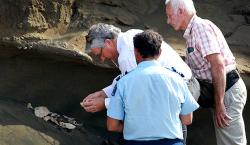 New Plymouth's Back Beach - An archaeologist who removed ancient human remains discovered in cliff tops south of New Plymouth's Back Beach, believes there could be more skeletons in the area. He said it appeared it had been a shaft burial, a traditional Maori form, and believed there could be other remains in the area. "It looks to me as if it is an old urupa (cemetery). There is certainly one individual buried in one deliberate grave and it would appear that there are human remains from areas away from the clear grave." Mr Bruce said the remains were very old, between 200 and 800 years, and there were other archaeological sites in the immediate area. "They are associated with very old artefacts – what we would refer to as archaic, so it is potentially a very old site." The sex, age and physical condition of the person at the time of death could be ascertained from the remains. "There's the potential to find really interesting and valuable information about the daily life of people from their bones."
New Plymouth's Back Beach - An archaeologist who removed ancient human remains discovered in cliff tops south of New Plymouth's Back Beach, believes there could be more skeletons in the area. He said it appeared it had been a shaft burial, a traditional Maori form, and believed there could be other remains in the area. "It looks to me as if it is an old urupa (cemetery). There is certainly one individual buried in one deliberate grave and it would appear that there are human remains from areas away from the clear grave." Mr Bruce said the remains were very old, between 200 and 800 years, and there were other archaeological sites in the immediate area. "They are associated with very old artefacts – what we would refer to as archaic, so it is potentially a very old site." The sex, age and physical condition of the person at the time of death could be ascertained from the remains. "There's the potential to find really interesting and valuable information about the daily life of people from their bones."
http://www.stuff.co.nz/national/6696931/Human-bones-found-in-Taranaki-cliff
FRANCE – 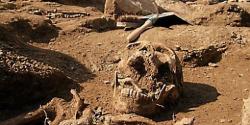 Béragne - Plus de 300 sépultures médiévales sur un même site : "C’est la première fois en Languedoc que nous avons accès à un cimetière de cette ampleur, que l’on peut fouiller en totalité dans le cadre de fouilles préventives". Pierre-Arnaud de Labriffe, de la direction régionale des affaires culturelles Languedoc-Roussillon, et Jérôme Hernandez, archéologue de l’Inrap ne cachaient pas leur satisfaction, hier, sur le domaine de Béragne, près de Trèbes. Ces terrains avaient fait l’objet d’une première série de fouilles. Des traces du néolithique, de l’âge du bronze et du fer, une ferme gauloise et un habitat médiéval (du XIIe au XIV e siècles) avaient alors été mis au jour. A l’ouest du site apparaît l’habitat, fait de pierres, ce qui est plutôt rare dans la région, et un espace constitué d’une centaine de silos. Vient ensuite une église en pierres, côté chœur, en bois et terre, côté nef : "En vis-à-vis, on trouve ce cimetière clos, composé d’une population d’hommes, de femmes et d’enfants, et d’une densité rappelant les cimetières urbains, alors que nous sommes en milieu rural", note Jérôme Hernandez. Les ossements découverts sont extrêmement bien conservés. Ce qui permettra, en laboratoire, d’étudier plus en détail des éléments riches d’enseignement. C’est le travail de l’anthropologue biologiste Richard Donat : "Un examen complet des 300 squelettes permettra de mettre en évidence les lésions pathologiques, qui nous aiguilleront sur le mode de vie et l’environnement de cette population. Sur les premières observations, on note cependant que cette dernière avait accès à une médecine d’un certain niveau (amputations, trépanations...), ce qui était très rare pour l’époque".
Béragne - Plus de 300 sépultures médiévales sur un même site : "C’est la première fois en Languedoc que nous avons accès à un cimetière de cette ampleur, que l’on peut fouiller en totalité dans le cadre de fouilles préventives". Pierre-Arnaud de Labriffe, de la direction régionale des affaires culturelles Languedoc-Roussillon, et Jérôme Hernandez, archéologue de l’Inrap ne cachaient pas leur satisfaction, hier, sur le domaine de Béragne, près de Trèbes. Ces terrains avaient fait l’objet d’une première série de fouilles. Des traces du néolithique, de l’âge du bronze et du fer, une ferme gauloise et un habitat médiéval (du XIIe au XIV e siècles) avaient alors été mis au jour. A l’ouest du site apparaît l’habitat, fait de pierres, ce qui est plutôt rare dans la région, et un espace constitué d’une centaine de silos. Vient ensuite une église en pierres, côté chœur, en bois et terre, côté nef : "En vis-à-vis, on trouve ce cimetière clos, composé d’une population d’hommes, de femmes et d’enfants, et d’une densité rappelant les cimetières urbains, alors que nous sommes en milieu rural", note Jérôme Hernandez. Les ossements découverts sont extrêmement bien conservés. Ce qui permettra, en laboratoire, d’étudier plus en détail des éléments riches d’enseignement. C’est le travail de l’anthropologue biologiste Richard Donat : "Un examen complet des 300 squelettes permettra de mettre en évidence les lésions pathologiques, qui nous aiguilleront sur le mode de vie et l’environnement de cette population. Sur les premières observations, on note cependant que cette dernière avait accès à une médecine d’un certain niveau (amputations, trépanations...), ce qui était très rare pour l’époque".
http://www.midilibre.fr/2012/04/06/un-cimetiere-medieval-mis-au-jour-a-beragne,482580.php
PALESTINE – 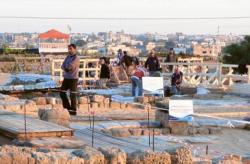 Tell Umm Al Amr - The Consulate of France in Occupied Jerusalem, with the French Foreign Ministry and Unesco, endorsed the preservation and restoration work led by a French archaeologist, René Elter, of St Hilarion's Monastery in Gaza, in November 2010. As described by Elter at an international scientific seminar about "Placing Value on Palestinian Patrimony" in Paris recently, the monastery is located on the Tell Umm Al Amr excavation site in the centre of the Gaza Strip, and depicts the stratification of history: the site shows the remains of three different churches and the influence of Byzantine and Umayyad architecture. Elter and his Palestinian colleagues have worked to preserve the site from erosion and terrain degradation caused by heavy rains that have led to the caving in of entire mosaics within the central crypt — believed to be the largest ancient crypt in the Arab world with over 60 sepulchres. In October 2011, St Hilarion's Monastery was listed by the World Monument Watch as one of the top archaeological sites around the world that requires most urgent attention. Gaza is replete with archaeological arte-facts from different eras. Any construction site will throw up all kinds of pottery, ceramics, statues and columns. As a crossroads and stopping point for armies and merchants travelling from Syria to Egypt or from the monasteries of Syria to St Catherine's in the Sinai, St Hilarion's Monastery also consisted of a boarding house for travellers and pilgrims. Like elsewhere in Western Asia and North Africa, remnants of Roman columns were reused in the architectural structures and the floors were made of incredible Byzantine fusaifisat (mosaics) depicting fruits, animals and intricate geometric designs later adopted in Arab art.
Tell Umm Al Amr - The Consulate of France in Occupied Jerusalem, with the French Foreign Ministry and Unesco, endorsed the preservation and restoration work led by a French archaeologist, René Elter, of St Hilarion's Monastery in Gaza, in November 2010. As described by Elter at an international scientific seminar about "Placing Value on Palestinian Patrimony" in Paris recently, the monastery is located on the Tell Umm Al Amr excavation site in the centre of the Gaza Strip, and depicts the stratification of history: the site shows the remains of three different churches and the influence of Byzantine and Umayyad architecture. Elter and his Palestinian colleagues have worked to preserve the site from erosion and terrain degradation caused by heavy rains that have led to the caving in of entire mosaics within the central crypt — believed to be the largest ancient crypt in the Arab world with over 60 sepulchres. In October 2011, St Hilarion's Monastery was listed by the World Monument Watch as one of the top archaeological sites around the world that requires most urgent attention. Gaza is replete with archaeological arte-facts from different eras. Any construction site will throw up all kinds of pottery, ceramics, statues and columns. As a crossroads and stopping point for armies and merchants travelling from Syria to Egypt or from the monasteries of Syria to St Catherine's in the Sinai, St Hilarion's Monastery also consisted of a boarding house for travellers and pilgrims. Like elsewhere in Western Asia and North Africa, remnants of Roman columns were reused in the architectural structures and the floors were made of incredible Byzantine fusaifisat (mosaics) depicting fruits, animals and intricate geometric designs later adopted in Arab art.
http://gulfnews.com/news/region/palestinian-territories/the-land-of-their-forefathers-1.1003548
PAKISTAN – 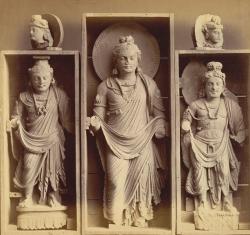 Mardan - The Khyber Pakhtunkhwa Archaeology Department has launched a new project of research analysis along with excavation at the ancient ruins in Jamal Garhi and Takht Bhai in Mardan district, officials said. The teams of noted archeologists, research scholars and students under the supervision of the KP Director Archaeology Dr Shah Nazar Khan had been busy in the fieldwork at the twin world-famous sites of the Buddhist era in Mardan. Describing the importance of the Jamal Garhi ruins, he said the site was excavated at irregular intervals since 1860 during the British rule. He reminded it was said that unknown British explorers took away 12 loaded camels of sculptures and artifacts when the site was unofficially excavated 150 years ago. The archeologist said that in 1873 the British carried out excavation of the Jamal Garhi ruins and the sculptures that were found were shifted to the British Museum in London and the Kolkata Museum in India. He said later in the 1920 under the Ancient Monument Act, the Jamal Garhi ruins were officially declared to be preserved. He said the ruins comprised of a stupa, monastery and halls of monks. He said the famous and unique ‘Fasting Buddha’ sculpture was also excavated from the Jamal Garhi site.He added the old data about the ancient sites in Jamal Garhi and Takht Bhai would be analysed on modern lines.
Mardan - The Khyber Pakhtunkhwa Archaeology Department has launched a new project of research analysis along with excavation at the ancient ruins in Jamal Garhi and Takht Bhai in Mardan district, officials said. The teams of noted archeologists, research scholars and students under the supervision of the KP Director Archaeology Dr Shah Nazar Khan had been busy in the fieldwork at the twin world-famous sites of the Buddhist era in Mardan. Describing the importance of the Jamal Garhi ruins, he said the site was excavated at irregular intervals since 1860 during the British rule. He reminded it was said that unknown British explorers took away 12 loaded camels of sculptures and artifacts when the site was unofficially excavated 150 years ago. The archeologist said that in 1873 the British carried out excavation of the Jamal Garhi ruins and the sculptures that were found were shifted to the British Museum in London and the Kolkata Museum in India. He said later in the 1920 under the Ancient Monument Act, the Jamal Garhi ruins were officially declared to be preserved. He said the ruins comprised of a stupa, monastery and halls of monks. He said the famous and unique ‘Fasting Buddha’ sculpture was also excavated from the Jamal Garhi site.He added the old data about the ancient sites in Jamal Garhi and Takht Bhai would be analysed on modern lines.
http://www.thenews.com.pk/Todays-News-7-101456-Project-launched-to-analyse-ancient-ruins-in-Mardan
EGYPTE – 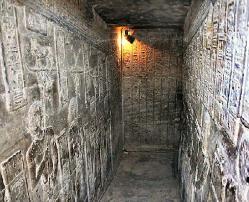 Denderah - The temple is famous for its beautiful wall reliefs, painted with religious scenes and inscriptions. Nowadays the reliefs show considerable damage, particularly due to salt weathering processes. In particular, the wall reliefs show salt crystallization at varying levels, in and between grains, and within the cement materials. The change in temperature and relative humidity in the studied area play an important role in the salts crystallization and hydration causing several deterioration features such as cracks, powdering, paint and plaster detachment, flaking, discoloration and iron oxides stains. Several samples were examined by polarizing microscopy (PLM), X-ray diffraction analysis (XRD) and scanning electron microscopy equipped with an energy dispersive X-ray analysis system (SEM-EDX). The results reveal that the damage in wall paintings are mainly attributed to the effect of different salts such as gypsum (CaSO4•2H2O), anhydrite (CaSO4), halite (NaCl), mirabilite (Na2SO4.10H2O) and sylvite (KCl). These results allowed the identification of the types of salts and deterioration features, information that may be used in the future for conservation purposes.
Denderah - The temple is famous for its beautiful wall reliefs, painted with religious scenes and inscriptions. Nowadays the reliefs show considerable damage, particularly due to salt weathering processes. In particular, the wall reliefs show salt crystallization at varying levels, in and between grains, and within the cement materials. The change in temperature and relative humidity in the studied area play an important role in the salts crystallization and hydration causing several deterioration features such as cracks, powdering, paint and plaster detachment, flaking, discoloration and iron oxides stains. Several samples were examined by polarizing microscopy (PLM), X-ray diffraction analysis (XRD) and scanning electron microscopy equipped with an energy dispersive X-ray analysis system (SEM-EDX). The results reveal that the damage in wall paintings are mainly attributed to the effect of different salts such as gypsum (CaSO4•2H2O), anhydrite (CaSO4), halite (NaCl), mirabilite (Na2SO4.10H2O) and sylvite (KCl). These results allowed the identification of the types of salts and deterioration features, information that may be used in the future for conservation purposes.
http://egyptology.blogspot.fr/